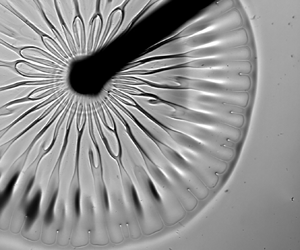Published online by Cambridge University Press: 07 March 2023

Marangoni spreading on thin films is widely observed in nature and applied in industry. It has serious implications for airway drug delivery, especially in surfactant displacement therapy. This paper reports the results of experimental investigations of a surfactant-laden droplet spreading on films made of more viscous Newtonian fluids as well as on films made of viscoelastic fluids. The experiments used particle seeding, the transmission-speckle method and particle tracking velocimetry (PTV) to determine the deformation of the film–droplet interface and to measure velocity fields. Radially aligned patterns were observed on Newtonian films. Similar patterns, but with much smaller wavenumber, were observed on viscoelastic films in combination with rapid azimuthal variations of the film thickness. The Saffman–Taylor instability at the film–droplet interface explains the formation of patterns on a more viscous Newtonian film, and their onset requires exceeding the critical capillary number. The pattern formation on viscoelastic films is correlated with an instability at the film–droplet–air contact line when the liquid is expelled radially by the spreading droplet. PTV revealed azimuthal variations of the velocity field in the vicinity of the contact line. The observed contact line instability is different from previously reported fingering instabilities of Newtonian thin films. A simple scaling law accounting for the Marangoni-stress-induced elastic shear deformation is proposed to describe the flow field in the patterns formed in the viscoelastic films.
Spreading of a surfactant-laden aqueous droplet on a more viscous viscoelastic (left) and Newtonian (right) thin liquid film. Both films have similar viscosities (22.7 mPa.s for the viscoelastic Boger 2 fluid, 21.5 mPa.s for the Newtonian PEG solution, fluid properties are given in Table 1). Rib-like structures characterized by low wavenumbers are formed at the Boger film - droplet interface (left), whereas radially aligned structures characterized by large wavenumbers are formed at the Newtonian film-droplet interface (right). Many very small fingers form at the end of spreading on Boger film (left) after deposition of a second surfactant-laden droplet.
To send this article to your Kindle, first ensure no-reply@cambridge.org is added to your Approved Personal Document E-mail List under your Personal Document Settings on the Manage Your Content and Devices page of your Amazon account. Then enter the ‘name’ part of your Kindle email address below. Find out more about sending to your Kindle. Find out more about saving to your Kindle.
Note you can select to save to either the @free.kindle.com or @kindle.com variations. ‘@free.kindle.com’ emails are free but can only be saved to your device when it is connected to wi-fi. ‘@kindle.com’ emails can be delivered even when you are not connected to wi-fi, but note that service fees apply.
Find out more about the Kindle Personal Document Service.
To save this article to your Dropbox account, please select one or more formats and confirm that you agree to abide by our usage policies. If this is the first time you used this feature, you will be asked to authorise Cambridge Core to connect with your Dropbox account. Find out more about saving content to Dropbox.
To save this article to your Google Drive account, please select one or more formats and confirm that you agree to abide by our usage policies. If this is the first time you used this feature, you will be asked to authorise Cambridge Core to connect with your Google Drive account. Find out more about saving content to Google Drive.